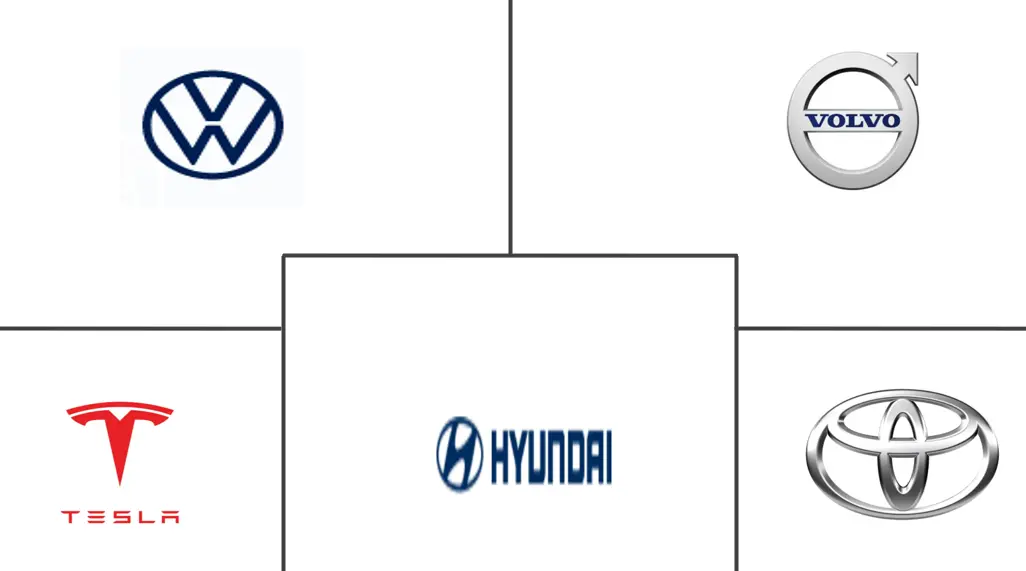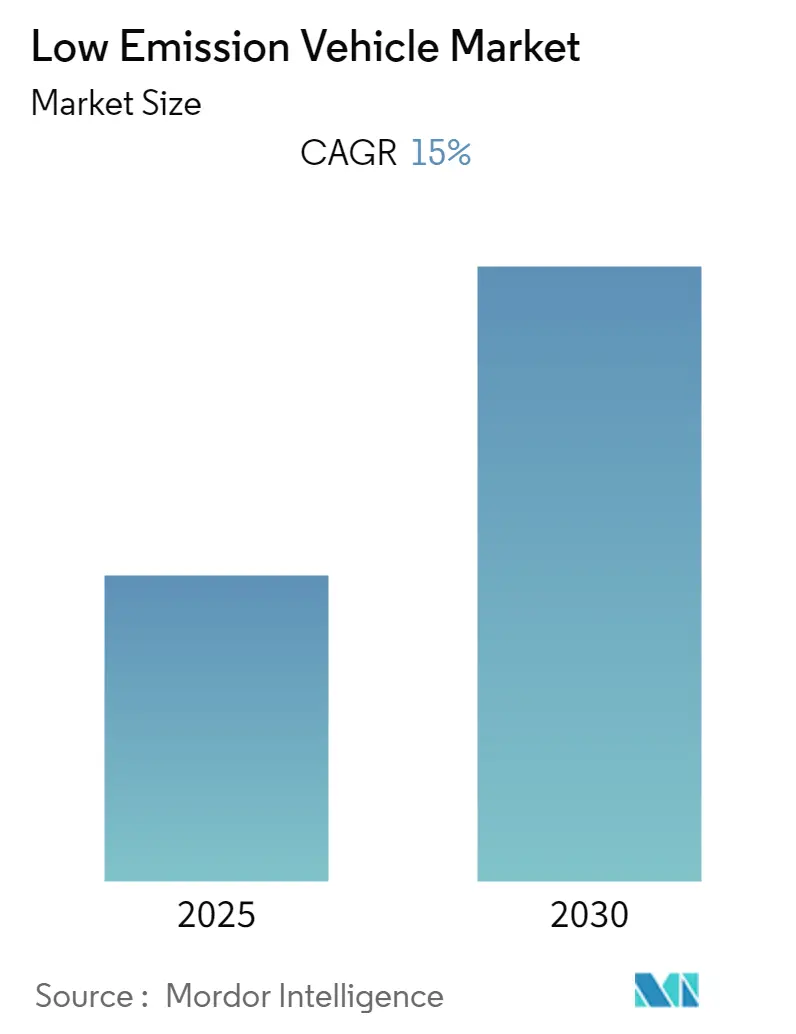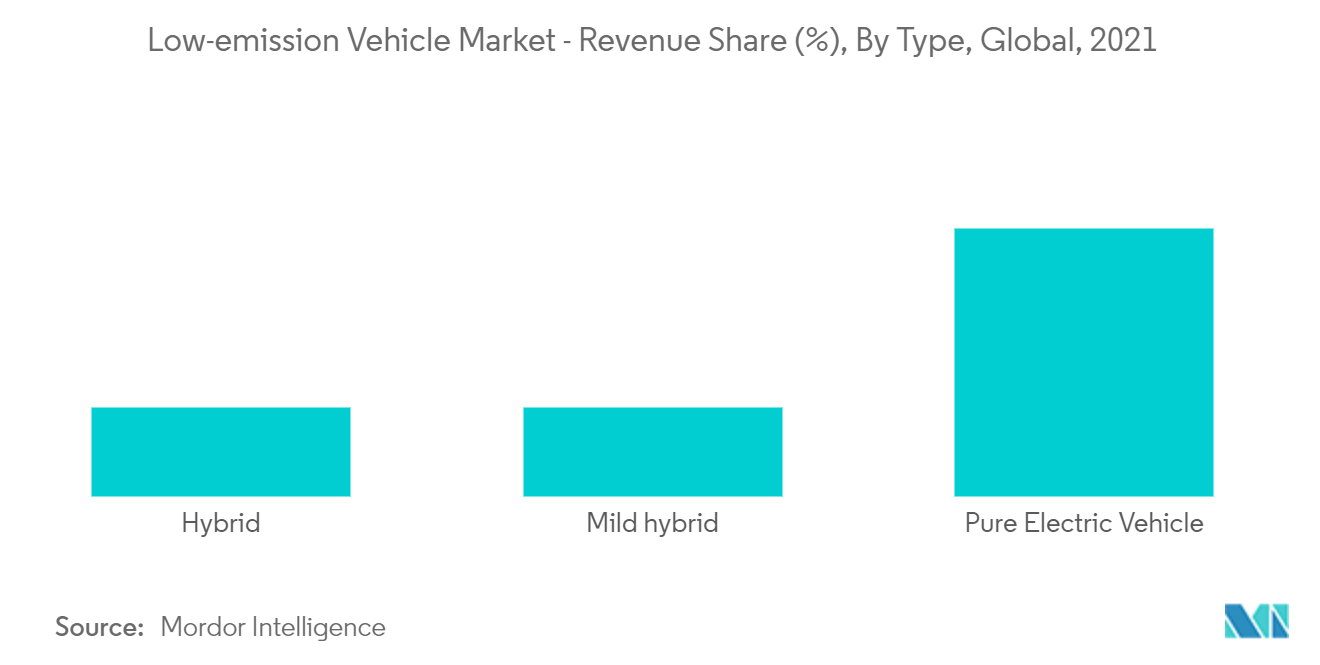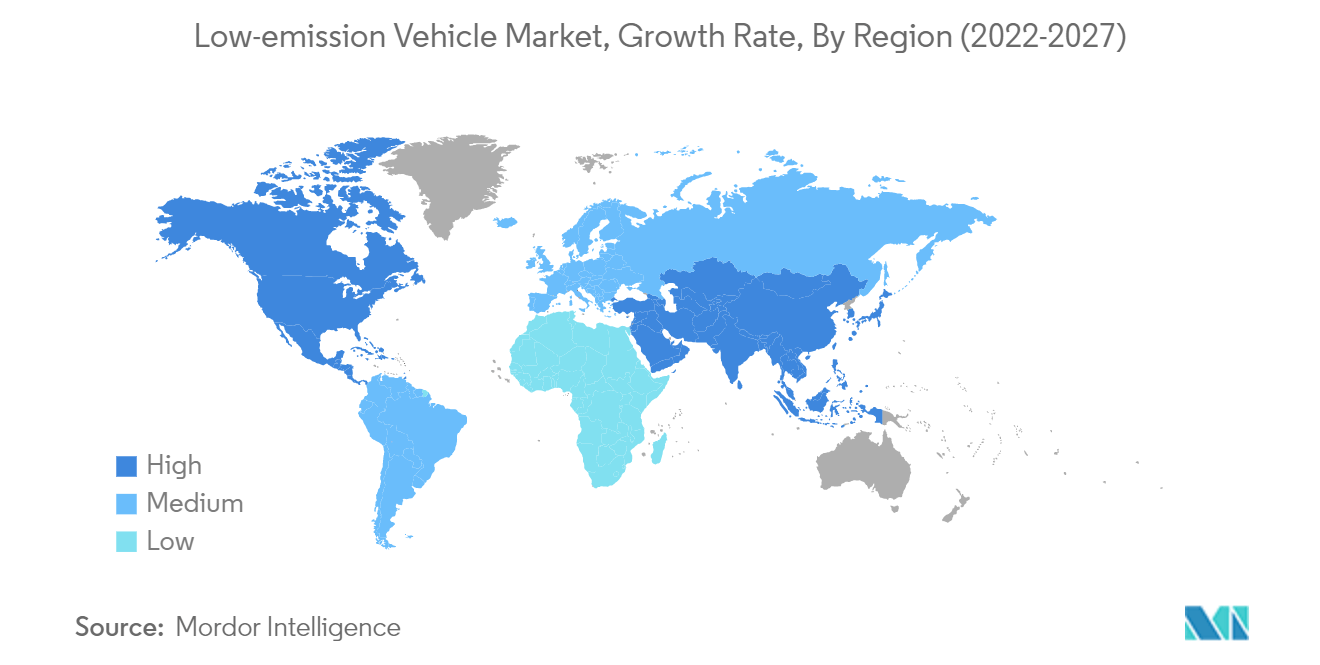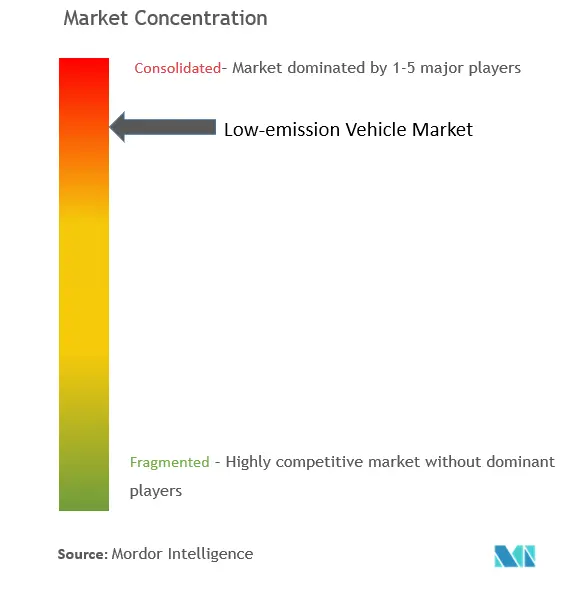Low-Emission Vehicle Market Analysis
The Low Emission Vehicle Market is expected to register a CAGR of 15% during the forecast period.
- During the lockdowns, the COVID-19 pandemic compelled about 95% of all automotive companies to put their workforces on hold. Globally, the repercussions of the lockdown have been immense and unprecedented in the automotive sector due to the halt of manufacturing activities. However, the market has regained momentum as economic activities resume and vehicle production also rises worldwide.
- Over the medium term, Government policies to support the growth of electric vehicles and plans to enlarge the electric vehicle charging infrastructure are expected to remain prominent market drivers during the forecast period. Several regional governments have announced their plans to have a certain portion of their new vehicle sales be electric in the upcoming few years.
- Electric car sales reached a record 3 million in 2020, up 40% from 2019. This strong growth was a stark contrast to general car market sluggishness globally, with overall car sales down 16% due to the Covid-19 crisis. After a decade of rapid growth, over 10 million electric cars are on the road, representing ~1% of the global car stock. For 2030, the Net Zero Emissions by 2050 Scenario projects 300 million electric cars on the road, accounting for over 60% of new car sales, compared with only 4.6% in 2020. Early market data for 2021 sales suggests rapid growth in significant markets.
- The electric vehicle (EV) market witnessed significant growth due to the need to address future energy requirements. The need to attain sustainable transportation is vital in driving electric vehicle demand.
- The electric vehicle market is becoming an integral part of the automotive industry. It represents a pathway toward achieving energy efficiency, along with reduced emissions of pollutants and other greenhouse gases. Increasing environmental concerns and favorable government initiatives are some of the major factors driving the market growth. Rising energy costs and competition among emerging energy efficiency technologies are also expected to fuel the market growth.
Low-Emission Vehicle Market Trends
Favorable Government Policies and Regulatory Norms are Expected to Drive the Market
- The sales of electric vehicles are still majorly driven by the polic
- y environment. The ten leading countries (such as China, United States, Norway, Germany, Japan, United Kingdom, France, Sweden, Canada, and the Netherlands) in electric vehicle adoption have a range of policies in place to promote the sales of electric vehicles. Primary examples of these programs and initiatives are public procurement programs, financial incentives to facilitate EV production and acquisition, and cutting their usage cost (e.g., by offering free parking).
- A variety of regulatory policies at different administrative levels, such as fuel-economy standards and restrictions on the circulation of vehicles based on emissions performance, are also driving the market.
- For instance, Bharat Stage (BS) norms aim at tighter regulations by reducing the permissible level of tailpipe pollutants. For example, BS-IV - introduced in 2017, allowed 50 parts per million (ppm) of sulfur, while the new and updated BS-VI - applicable from 2020, allows only ten ppm of sulfur, 80 mg of NOx(Diesel), 4.5 mg/km of particulate matter, 170 mg/km of hydrocarbon and NOx together.
- With its FAME and FAME II policies, India is providing attractive options for investors and manufacturers to set up EV plants in the country to propel the country toward a faster adoption of green vehicles. Public transportation across many cities and countries is being reviewed, and subsequently, through subsidies, Electric buses are replacing ICE buses. For instance, in 2021, there were close to one thousand electric buses used in public transport in India. With 246 e-buses, Mumbai ranked the top in the country.
- Thailand has 1,000 charging stations across the country. One of their primary efforts is to have 53,000 electric motorcycle taxis and 5,000 electric buses on the road by the end of 2022 and 2025, respectively. The Asian Development Bank and Energy Absolute have signed a USD 48 million green loan to fund Thailand's nationwide electric vehicle charging network.
- The announcement of Malaysia's National Low Carbon Cities 2030 plan includes the creation of 200 low-carbon zones around the country, which might result in a more significant push for green transportation alternatives, including electric vehicles. Malaysia also intends to construct 25,000 public and 100,000 private charging stations by 2030.
China Is Expected To See Highest Growth
- With rapid urbanization, China is determined to reduce the polluting emissions from its road transport vehicles. At the same time, it also intends to reduce the country's dependence on hydrocarbon imports and support the development of the industrial sector. China is the largest manufacturer and consumer of electric vehicles in the world. National sales targets, favourable laws, supportive subsidies, and municipal air-quality targets are supporting domestic demand. For instance,
- China has by far the biggest electric vehicle industry in the world. As the largest EV manufacturer, China's EV production amounted to 3.5 million units in 2021, an increase of 1.6 times year-over-year. Revenues from the electric vehicle market reached approximately 102.2 billion U.S. dollars for the year, the highest in the Asia-Pacific region.
- China imposed a quota on manufacturers for 100% electric or hybrid vehicles, which must represent at least 10% of total new sales. Additionally, some major cities and provinces are imposing increasingly stringent restrictions. For instance, Beijing only issues 10,000 permits for registering combustion-engine vehicles per month to encourage its inhabitants to switch to electric vehicles. These measures are leading China to formulate resolute and optimistic prospects for the development of electric vehicles in the country, which is expected to drive the market.
- The growing government regulations improving electric vehicle adoption and robust expansion adopted by OEMs and suppliers in the region to accommodate rising demand from the automotive industry in China are expected to create a positive outlook for market growth during the forecast period. For instance,
- The government of China is encouraging people to adopt electric vehicles. The country has already made plans to phase out diesel fuel, which runs the current generation of tractors and construction equipment. The country is planning to ban diesel and petrol vehicles completely by 2040.
- In the last three years, nearly 60,000 light trucks and vans have been deployed for urban freight movement in Shenzhen, representing approximately 35% of the city's overall fleet of urban delivery vehicles.
- With the above-mentioned developments, low-emission vehicles are witnessing significant growth during the forecast period.
Low-Emission Vehicle Industry Overview
- The market for low-emission vehicles is characterized by the presence of both established companies and small start-ups. There are also a large number of regional players currently focusing on specific geographies. BYD is a major player in the market studied, owing to its growing orders for passenger cars and electric buses from domestic and international markets. The company sold 227,152 passenger vehicles in 2018, the highest among all companies in China. BYD also received an order to build 4,473 electric buses for Guangzhou city under the tender of a total of 4,810 electric buses. Other major companies are Tesla, Daimler, Volkswagen AG, Toyota Motor Corporation, Ford, and Geely Group.
- In April 2022, the Ministry of Economic Progress, Italy announced the provision to allocate EUR 650 million (USD 699 million) for each of the years 2022-2023-2024, which falls within the resources allocated by the Government to the Automotive Fund for which a total financial endowment of EUR 8.7 billion (USD 9.34 billion) has been provided until 2030. Incentives for purchasing electric, hybrid, plug-in, and endothermic vehicles are granted only to individuals. A small percentage of the funds is reserved for car-sharing companies to purchase electric, hybrid, and plug-in vehicles.
- The Canadian government established a sales mandate in May 2022 to guarantee that all new light-duty vehicle sales are ZEVs by the year 2035. The Government is investing up to CAD 529 million (USD 423 million) into this project
Low-Emission Vehicle Market Leaders
-
Tesla Inc
-
Volkswagen AG
-
Toyota Motor Corporation
-
Hyundai Motor Company
-
AB Volvo
- *Disclaimer: Major Players sorted in no particular order
Low-Emission Vehicle Market News
- August 2022: India's largest automaker Maruti Suzuki confirmed that it shall soon introduce its first electric vehicle latest by 2025 end. In addition, Its parent firm, Suzuki Motor Corporation, is looking forward to investing INR 10,400 crore (USD 127 million) in Gujarat to build a manufacturing plant to produce electric vehicles. The company said it would not only manufacture electric vehicles in the country but also start production of lithium-ion batteries, which are currently imported from other countries by several OEMs.
- January 2022: The Volkswagen Group and the Bosch Group signed a memorandum of understanding to explore the establishment of a European battery equipment solution provider. The two companies plan to supply integrated battery production systems and on-site ramp-up and maintenance support for battery cell and system manufacturers.
- December 2021: Hyundai India is switching to overdrive mode with its strategy to expand its electric vehicle range in India, as it announced six new electric vehicles to be introduced by 2028, besides investing Rs 4,000 crore towards developing these new models, and developing the charging infrastructure in the country. Hyundai will also present its globally acclaimed E-GMP modular platform to India and modified platforms to drive the adoption of Battery Electric Vehicles (BEVs) with a strong focus on local manufacturing synergies.
Low-Emission Vehicle Industry Segmentation
A low-emission vehicle is a motor vehicle that emits relatively low levels of emissions from the motor vehicle. Low-emission vehicles are the one that doesn't emit as much nitrous oxide (NOx) and carbon dioxide (CO2) pollution from the vehicle.
The low-emission vehicle market has been segmented by type, vehicle type, and geography. Based on the type, the market is segmented into hybrid, mild hybrid, and Pure Electric Vehicle. Based on the vehicle ype, the market is segmented into passenger cars and commercial vehicles. Based on geography, the market is segmented into North America, Europe, Asia-Pacific, and the Rest of the World.
For each segment, the market sizing and forecast have been done based on the value (USD billion).
| Vehicle Type | Passenger Car | ||
| Commercial Vehicles | |||
| Type | Hybrid | ||
| Mild Hybrid | |||
| Pure Electric Vehicle | |||
| Geography | North America | United States Of America | |
| Canada | |||
| Mexico | |||
| Rest of North America | |||
| Europe | Germany | ||
| United Kingdom | |||
| France | |||
| Italy | |||
| Spain | |||
| Rest of Europe | |||
| Asia-Pacific | India | ||
| China | |||
| Japan | |||
| South Korea | |||
| Rest of Asia-Pacific | |||
| Rest of the World | Brazil | ||
| Saudi Arabia | |||
| United Arab Emirates | |||
| South Africa | |||
Low-Emission Vehicle Market Research FAQs
What is the current Low Emission Vehicle Market size?
The Low Emission Vehicle Market is projected to register a CAGR of 15% during the forecast period (2025-2030)
Who are the key players in Low Emission Vehicle Market?
Tesla Inc, Volkswagen AG, Toyota Motor Corporation, Hyundai Motor Company and AB Volvo are the major companies operating in the Low Emission Vehicle Market.
Which is the fastest growing region in Low Emission Vehicle Market?
Asia-Pacific is estimated to grow at the highest CAGR over the forecast period (2025-2030).
Which region has the biggest share in Low Emission Vehicle Market?
In 2025, the North America accounts for the largest market share in Low Emission Vehicle Market.
What years does this Low Emission Vehicle Market cover?
The report covers the Low Emission Vehicle Market historical market size for years: 2019, 2020, 2021, 2022, 2023 and 2024. The report also forecasts the Low Emission Vehicle Market size for years: 2025, 2026, 2027, 2028, 2029 and 2030.
Our Best Selling Reports
Low Emission Vehicle Industry Report
Statistics for the 2025 Low Emission Vehicle market share, size and revenue growth rate, created by Mordor Intelligence™ Industry Reports. Low Emission Vehicle analysis includes a market forecast outlook for 2025 to 2030 and historical overview. Get a sample of this industry analysis as a free report PDF download.

